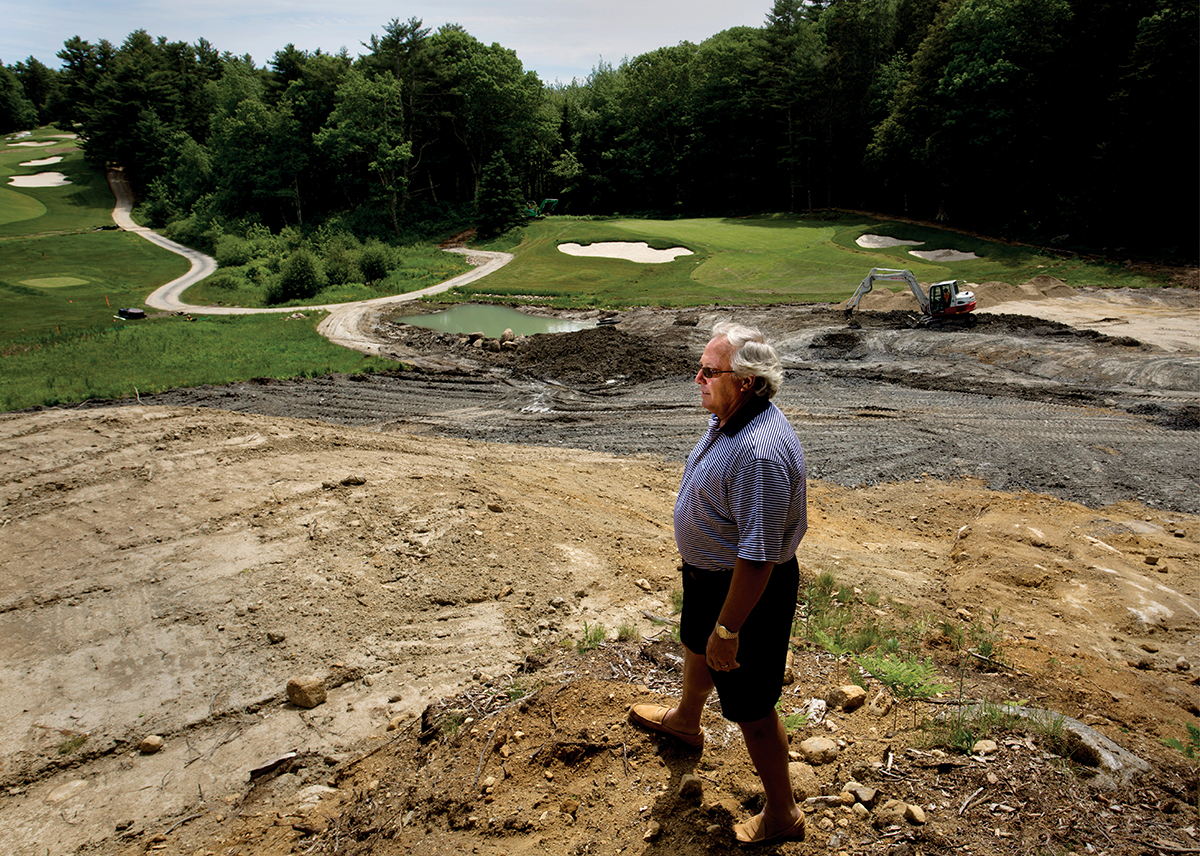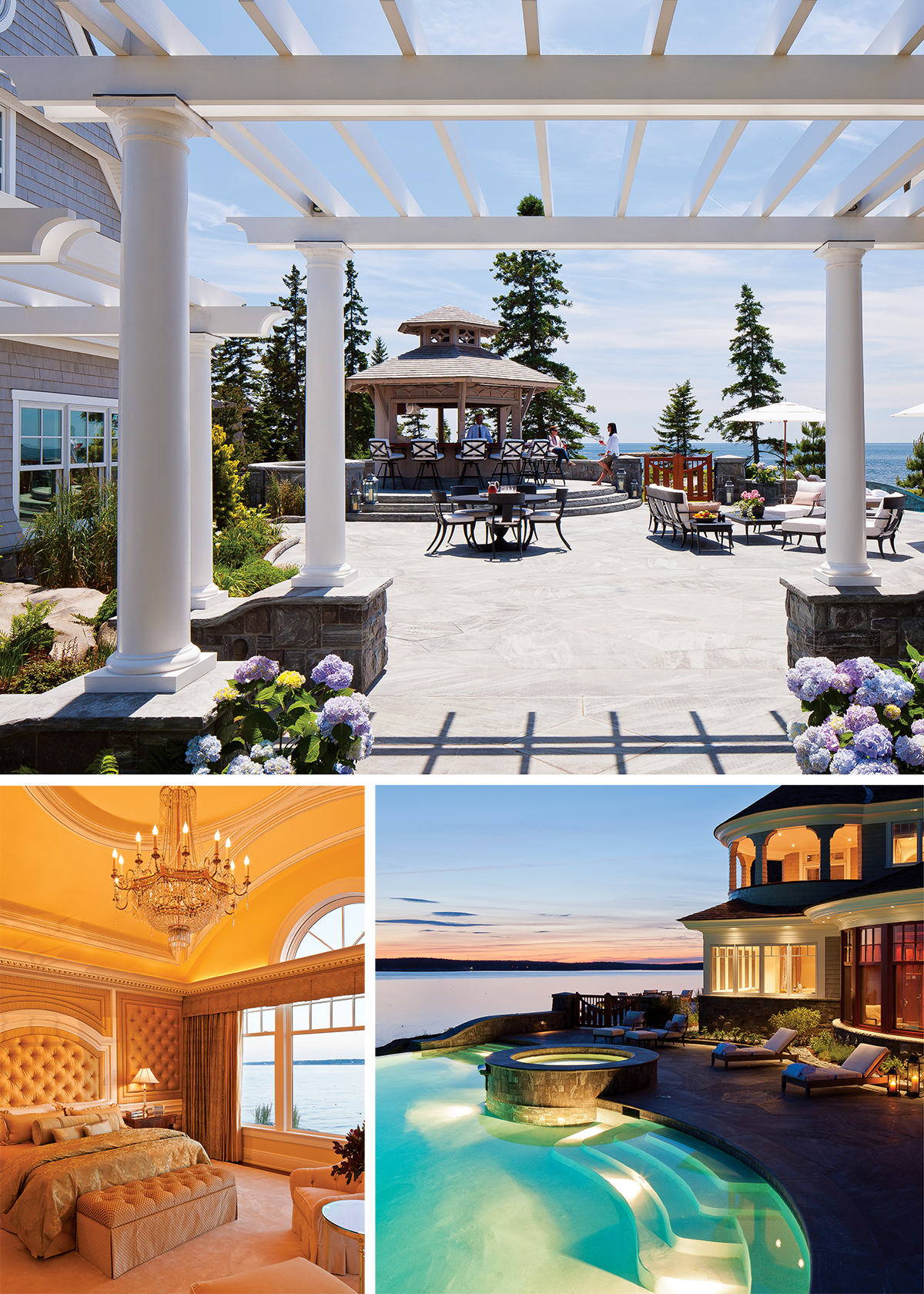Does Boothbay Have a Vodka Problem?

Paul Coulombe, owner of the Boothbay Harbor Country Club, tours the golf course he’s renovating. (Photograph by Portland Press Herald/getty images)
The guy you’ll want to thank for the existence of the best-selling, personal-fortune-making, all-but-undrinkable Pinnacle whipped-cream vodka is standing on a pile of rubble, wearing a pair of knee-high wellies and a shirt that’s unbuttoned halfway to his navel. It’s late March, and 62-year-old liquor magnate Paul Coulombe is observing the remnants of a mediocre golf course he’s in the process of luxe-ifying, from the hilly site of what will one day be a gargantuan clubhouse. “This view,” he comments, “is spectacular.” Swiveling his head to the left, he notices something less spectacular. “Now, we can see the cemetery, which I’m not that fond of.” A brief, slapstick discussion ensues, between him and his contractor, about the problem of the dead people across the street who are ruining the panorama. It is determined that the dead people can’t be moved.
It’s fairly clear that Paul Coulombe was never committed to the possibility of a mass unburial. Nonetheless, there’s symbolic value here: Coulombe is of the opinion that the town of Boothbay—along with neighboring Boothbay Harbor and Southport Island—is for all intents and purposes dead. “I always saw the town as kind of folding and getting passed by Camden or Kennebunkport or Bar Harbor,” says Coulombe, who has a tuft of white hair and a honking voice that makes his nose sound perpetually clogged. “There’s just not been investment, I hate to say it, in the last 50 or 60 years. So I’m the first one who’s come to this town and thought it was worth saving.”
In 2012 Coulombe sold off his Lewiston-based White Rock Distilleries for $605 million—in addition to Pinnacle, his other marquee brands included Three Olives vodka and Calico Jack rum—and has used his fortune and spare time to reinvent himself as Boothbay’s leading entrepreneur, philanthropist, and all-purpose agitator. Boothbay, an hour north of Portland, near the tip of one of Maine’s many peninsulas, is in the winter months an aged ghost town. Come May, it springs to life, but still doesn’t draw the crowds of the state’s more-pedigreed resort communities. On paper, Coulombe—and his cash—would seem like an obviously welcome arrival. Instead, his crass personal style and new-money bravado have had a profoundly alienating effect. Because what might seem to Coulombe like “saving” reads as “ruining” to many of his new neighbors. And while he may find preppy, moneyed Kennebunkport to be the epitome of a thriving summer destination, for much of Boothbay, it’s a loafers-and-popped-collar hellscape.
The tension that has emerged between Coulombe and his adopted hometown tugs at a larger debate over the fundamental character of Boothbay—and, by extension, coastal Maine. Coulombe, whose Formula One driving tendencies contributed to the installation of speed bumps in one part of town, can seem like he was pulled from rich-jerk central casting. The rest of Boothbay, by contrast, is generally divided between blueish-collar year-rounders and quietly wealthy summer folk. Kennebunkport’s version of celebrity is the Bushes; Boothbay Harbor’s is former NFL commissioner Paul Tagliabue. “Traditional summer people that I know or heard about didn’t believe in making big statements,” says Barbara Rumsey, a historian at the Boothbay Region Historical Society. “They came here to get away from that world, to just be ordinary people.”
Coulombe, meanwhile, is decidedly uninterested in behaving in an ordinary manner. Among his exploits: building a $30 million waterfront manse with 37 televisions and a Versailles-replica chandelier; transforming a historical lighthouse into a luxury inn; buying more than 30 properties to expand the Boothbay Harbor Country Club, where, incidentally, the cost of a membership will be doubling in 2016. Next up: a massive, secretive project to redevelop the area around the historical Boothbay Common into what was mysteriously described to me as a “village.”

An hourlong tour of the grounds includes stops at the infinity pool (bottom right) and the outdoor bar (top). In the “master wing” (bottom left), Coulombe gestures toward a custom-built, 14-karat-gold chandelier. “It’s really simplistic, but it’s actually gold,” he says. “It’s worth more than most homes are worth.” (photographs by brian vanden brink for the knickerbocker group)
This is a story that pits economic development against historical preservation; nouveau riche against old New England; change against stasis. But perhaps more than any of that, it’s the story about a little waterfront community holding its collective breath, waiting to see how far one man of almost unlimited means is willing to push his vision.
Back on the pile of rubble, at the country club, Coulombe diverts his attention to a slice of land where, in time, a spa, tennis courts, and potentially villas will sit. “We knocked down, I don’t want to say hundreds of trees, but quite a few trees,” he says. His amiable, mustachioed contractor, Steve Malcom, in what is perhaps an attempt at humor, chimes in: “But at the same time we were knocking trees down, we were knocking buildings down.” This delights Coulombe. “We’re not just going to offend a few of you!” he cackles. “We’re going to offend the whole bunch of you!”
Maine is a notoriously homogenous state. There are almost no black, Hispanic, or Asian people there. However, there’s one salient way the population seems to divvy itself up: Either you’re from here, or you’re from “away.” And Paul Coulombe is a case study in just how local you need to be to avoid “away” status. Considered by essentially everyone I spoke to while reporting this piece to be a carpetbagger, Coulombe was actually raised in Lewiston, 48 miles northwest of Boothbay. His father, Raymond Coulombe, was a hard, modest man with family ties in Québec. As a young man Raymond worked at a textile factory in Lewiston before relocating the family to Venezuela during the 1960s, as the industry moved out of the Northeast. When that didn’t work out—the story I heard involved a hostile socialist government and a bunch of machine guns—he returned to Lewiston and purchased White Rock Distilleries. For decades, under Raymond Coulombe’s leadership, White Rock was a low-key regional operation, distilling, among other unremarkable liquors, dirt-cheap Lawrence Screwdriver vodka.
Coulombe’s expensive habits, even at a young age, diverged sharply from his parents’ frugality. (“Even when I was completely penniless,” he tells me over a glass of wine, “I’d still drink good wine.”) Nonetheless, after Coulombe graduated from the University of Maine, his father lured him away from other job opportunities to work at White Rock.
Coulombe’s brother Dennis, who ran the firm’s day-to-day operations, was closer to his father than Paul was. But thanks to his talent for promotion and sales, it was Paul, not Dennis, who was eventually handed control of the company in 1995. What Coulombe understood was that to sell massive quantities of liquor, all he had to do was create slight variations on better, more popular liquors. For Three Olives, which he created in 1998, he cribbed Grey Goose’s frosted glass. For Pinnacle, which came later, he had it manufactured in France—again, just like Grey Goose (hence the nickname “Baby Goose”). Within a few years, Pinnacle and Three Olives were regularly among the bestselling vodkas in the country. And the whipped-cream variety became the lord of the flavoreds.
By the time Coulombe sold off Three Olives (he later sold off the rest of the company), he appeared headed for early retirement, deciding to travel with his new wife, Giselaine, a perky blonde from Toronto nearly 20 years his junior. (Coulombe had been a bachelor for a dozen years, following a brief first marriage that produced one daughter.) Then two things happened. First, he got bored. “I’m not ready to read a book, or go on an eternal cruise,” he realized.
Second, he decided it was time to fulfill a childhood fantasy. “Well, my initial dream, all my life, since I’ve been a little boy,” he said, “has been to own my own town.”
So he got to work. He had an emotional attachment to the Boothbay area from visiting with his family, and in 2008 he began building his home there, eventually constructing his nearly 18,000-square-foot Southport Island estate. Later, in 2013, he purchased the golf club several miles north, in Boothbay proper. Next came the expansion of the golf club, requiring, among other things, the uprooting of an almost 220-year-old Boothbay landmark, the Kenniston Hill Inn. (Coulombe agreed to displace rather than tear down the inn after a group of irate residents mobilized, but he isn’t doing himself any favors when he repeatedly refers to it in our conversations as the “Kensington Inn.”) Meanwhile, he got to work on a bevy of unrelated, equally disruptive projects: a massive (aborted) dredging project to facilitate the docking of his yacht; a bougie restaurant that took the place of a decades-old greasy spoon; the lighthouse inn for high-net-worth individuals; and, finally, the buying up of the area around Boothbay Common, for what will likely be his most ambitious project of all, potentially featuring dining options and boutiques.
As a result of this expansionary zeal, Coulombe has more or less divided the town between the folks who loathe him unconditionally and the smarmy yes men who’ve gravitated to his cause. (“Many people have not seen the light of day since he came to town,” one local said of the ass-kissing/brownnosing contingent.) But Coulombe’s majesty is such that he’s found a way to rub even the moderates the wrong way.
Gerry Gamage is one of these people. He’s a former lobsterman, a volunteer fire chief, and the chair of the Southport Board of Selectmen. Ruddy-faced, with a characteristically thick Maine accent, Gamage brushes away talk that Coulombe’s money alone is somehow destroying the fabric of the community. “The bigger the tax base, the easier it is on all taxpayers,” he points out. “He’s helping in that regard.” Yet there’s something about Coulombe that Gamage can’t quite stomach. Part of it’s the hubris. (“Guess what,” he says of Coulombe’s possibly daft notion to build a luxury inn on a large rock in the ocean, “the Atlantic Ocean doesn’t care what Paul Coulombe thinks.”) But mostly I got the sense that Gamage’s objections come back to the inescapable, slightly uncomfortable question of who belongs in Boothbay and who doesn’t.
“People move here from away,” Gamage says, “because they don’t like the way things are going there. But they bring their ideas here and try to instill them on us. And they forget that they left there because they didn’t care for it there! A lot of people don’t get it. They can’t stand back far enough to see what they’re doing.”
In 1939, a local artist named Asa Randall took to the pages of the Boothbay Register to warn of the dangers of overdevelopment: “In improving the town and increasing business,” he wrote, “there is a danger worse than a destructive fire.” Seventy-six years later, Boothbay is still mired in an existential crisis, unsure if it’s a working-class lobster depot or a summer resort town.


